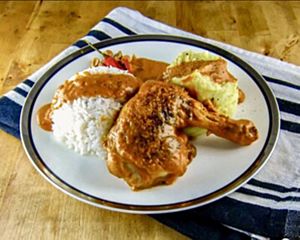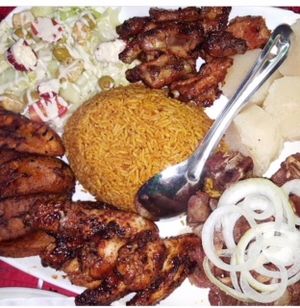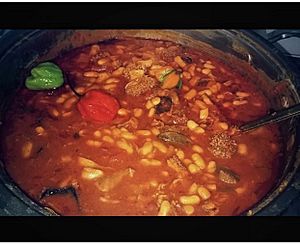Congolese cuisine facts for kids
The cuisine of the Democratic Republic of the Congo and the Republic of the Congo is super diverse! It shows off the amazing foods of the local people. Staple foods like cassava, fufu, rice, plantains, and potatoes are eaten with many other tasty side dishes.
Common Congolese Dishes

Even though only a small part of the land is farmed, it grows many different crops. These include maize (corn), rice, cassava, sweet potatoes, yams, taro, plantains, tomatoes, pumpkin, and various peas and nuts. People eat these foods all over the country. However, some dishes are special to certain regions.
People also gather wild plants, fruits, mushrooms, and honey. They also hunt for bushmeat and catch fish. These foods are often sold at markets or by the roadside. It can be hard to raise cattle or run big farms because of challenges with the road system.
Congolese meals usually have a starchy food. They also include vegetables and meat cooked in a stew. The starch often comes as a paste or mash. This is made from cassava or corn flour. It is called fufu or ugali. When you eat fufu, you roll it into small balls. Then you dip them into the spicy stew. Sometimes, you make a little dip with your thumb to scoop up sauce.
A type of fermented bread called kwanga is made from cassava. It is sold all over the country. Lituma is a popular plantain dish. It is made from mashed plantains shaped into balls and baked. Sweet potatoes are prepared in a similar way. In some areas, they are mixed with roasted peanuts. Rice is often mixed with beans.
To go with these starchy foods, people often add green vegetables. These include cassava leaves, tshitekutaku (like spinach), and okra. Mushrooms are very popular, especially among the Luba people. They are often used instead of meat when meat is scarce. Most meals are eaten without meat because it can be expensive.
Fish are found in large numbers along the Congo River. They are also in its smaller rivers and lakes. Fish are baked, boiled, or fried to eat right away. They can also be smoked or salted to save for later. Markets often sell ready-to-eat peppered fish. These are baked inside banana leaves. Goat meat is eaten more than any other meat. Mwambe is a common way to cook chicken. It uses peanut sauce. People also eat edible insects like grasshoppers and caterpillars. They often taste nutty.
Sauces for these dishes can be made with tomatoes and onions. Local aromatic herbs are also used. Vegetable oil, salt, hot red chile pepper, and sweet green pepper add extra flavor. These spices are used less often in the far south.
Nganda Restaurants: Local Eateries
Kinshasa has many nganda restaurants. These are special restaurants that serve food from different parts of the country. They also offer Western foods like bread and beer. Nganda are often owned by women. They are a mix between bars and restaurants. Here are three common types of nganda restaurants:
- Riverside nganda serve baked fish with cooked plantains. These recipes come from upriver areas.
- Kongo nganda serve fish dishes with a vegetable sauce. They are eaten with kwanga. These dishes come from downriver from Kinshasa.
- Kasai nganda serve goat meat with rice and green vegetables. They might also serve rabbit for special occasions.
Nganda restaurants serve many different kinds of people. They are popular with workers, professionals, and government officials.
List of Congolese Foods

Here is a list of some popular Congolese foods:
- Moamba – A sauce or dish often made with peanut butter.
- Ngai ngai ya musaka – A sauce or dish made from the outer part of palm nuts. Ngai ngai is a leaf, also called sorrel.
- Chikwangue or kwanga – Made from cassava, cooked and wrapped in banana leaves. It can be dark or nearly white.
- Fufu – A sticky, dough-like dish made of cassava flour. It's a main food, like rice or potatoes in other countries.
- Loso na madesu – Rice and beans.
- Sombe or pondu – A soup made from boiled, pounded, and cooked cassava leaves.
- Ndakala – Small dried fish.
- Pili pili – A very hot pepper. It is served with almost everything. Sometimes it's dried and sprinkled on fruit!
- Palm wine – Made from the sap of a wild palm tree. It ferments naturally and has a small amount of alcohol.
- Mbembe – Snails.
- Mulenda, or dongo-dongo – Okra.
- Soso – Chicken and rice.
- Ntaba or ngulu yako tumba – Grilled goat or pork.
- Mbisi ya Mayi (poisson de mere) – Fish.
- Liboke ya mbika – Steamed pumpkin-seed pudding.
- Liboke ya ngulu – Pork pepper soup steamed in banana leaves.
- Liboke ya mbisi – Fish (often catfish) pepper soup steamed in banana leaves.
- Mikate – Deep-fried dough balls.
- Makelele – grasshoppers.
- Pain mwambe – Peanut butter bread.
- Makayabu – Salt fish.
- Kamundele – Kebab sticks, which are beef on skewers.
- Thomson – Horse mackerel.
- Mbewngi – Black-eyed peas.
- Loso ya bulayi – Congolese jollof rice.
- Madesu – Bean stew.
- Pondu ya madesu – Cassava leaf and bean stew.
- Dabo kolo – Small pieces of baked bread.







